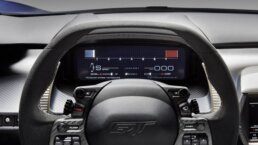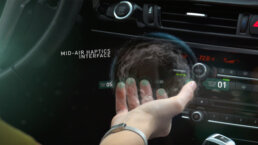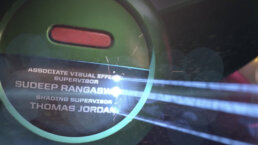Everybody wants to have a hologram. Whether it’s for receiving the latest news updates or visualizing tabletop gaming, holograms could have a huge impact on our society. Really, holograms have already been impacting society for over 50 years, and they aren’t even real – yet!
Holograms have been considered a staple of science fiction media ever since their first film appearance in Star Wars: Episode IV – A New Hope. We all remember seeing a projection of a blue-hued Leia Organa saying, “help me, Obi Wan Kenobi, you’re my only hope”. Since then, holograms have become more common, and more advanced, in film. They’re something that helps show the technological prowess of a film’s setting or characters and they’re a great way to progress the plot.
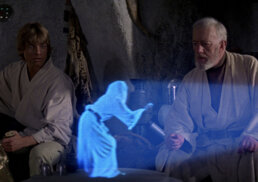
At Perception, we have been conceptualizing holograms and other futuristic tech for over a decade, each with their own unique and distinguishable design. One of the greatest challenges we face is determining how we can make a piece of science fiction technology that isn’t real yet appear as if it could exist in our world.
When it comes to conceptualizing holograms, we find that one of the most important steps to take is considering how the hologram would actually work. We don’t just think about the final design. We have to consider how the hologram is made, who is using it and what the purpose of the hologram is. Holograms are an integral way of communicating and helping both the characters and the viewer understand data in a 3D form. Their value and importance leads our team to giving all of our holograms a background and a story. This helps us better understand the technology and how we can best depict it in a futuristic, yet realistic, manner.

What the hologram is being projected from is just as important as the hologram itself. Most characters will use holograms for the same purpose, whether that is collecting information, watching footage or talking to other characters in a different place. We find that the technology used to create the hologram is something crucial to focus on. All holograms can be considered magic, but if you define how the hologram is made and pull back that curtain, the hologram will feel less like magic and more practical. One way we like to showcase this is through adding flaws to the technology of the hologram.
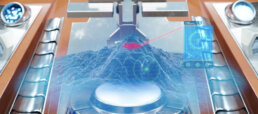
Light isn’t perfect. It can be bent, interrupted and unstable. Therefore, a light-based hologram wouldn’t be perfect either. We like to bring in some degradation to the hologram. Our team will gather around and brainstorm questions such as if a hologram is being emitted from a projector, where could that go wrong? What could we add to demonstrate the flaws of that technique? If the hologram is made from light spinning upwards to form a picture, how could that be interrupted?
Artfully, we have to break the hologram. Whether that is through flickers, shakiness or glitches, the hologram should be able to have some defects and restraints.
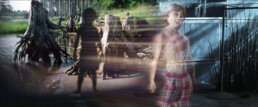
We like to look at the holograms used in Minority Report as reference. During the projection of a home movie, the hologram shows that it produces shadows of a child and cannot depict anything behind the holographic child. This is giving the hologram reasonable limitations, allowing it to feel more tangible.
By adding these limits, breaks and noise, the hologram becomes more realistic. No matter how advanced it is, every piece of technology has its flaws. By not including any flaws in a hologram, it seems too far off from what is possible. The more detail we add leads to more realism that the hologram holds.
Another method we like to use when crafting holograms is considering the setting of the hologram. Integrating lighting and shadows is one of our favorite tricks. If we’re crafting holograms for a film, we like to take reference from existing footage. We will study how the shadows fall and where the lighting is coming from. We’ll add these elements to our hologram to help it naturally blend with the environment.
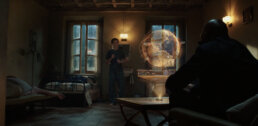
Standard holograms are typically seen as bright, glowing projections. At Perception, we’ll add photorealistic passes and approach our holograms with an augmented reality style design to enhance its realism.
Utilizing lighting was one of the biggest contributing factors to the holograms that our team designed for Secret Headquarters. Since many of these holograms appear in an underground hideout with a unique style of lighting, we kept the brightness of the holograms subdued. The lighting of the headquarters is on the darker end of the spectrum. Having our holograms appear as incredibly bright with a heavy orange glow would not match the environment. Instead, we followed the pattern of the shadows and lowered lighting to allow our holograms to enhance the scene instead of overwhelm it.
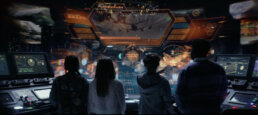
While holograms aren’t completely real, our goal is to craft holograms that feel tangible and possible. If Tony Stark could experiment with a holographic periodic table or Thor could check heat signatures inside a holographic mountain, perhaps one day we’ll be able to interact with our very own holograms. By looking at the valuable designs and functions of holograms in science-fiction, we’ll be one step closer to that future.
Doug Appleton
Doug Appleton is Perception’s resident VFX wizard. Formally taught in the world of motion graphics, Doug’s first job out of college was at Perception. He has been with the studio ever since.
Doug has grown with the team from their early days and has continued to flourish up the hierarchy as he learns and masters the intricacies of the film and technology worlds. His skill in successfully executing a diverse array of projects in the world of motion is matched only by his curiosity of the technology itself.
Doug’s projects have ranged from detailed UX interface projects for high profile security clients, to lead animator on title sequences for Avengers: Age of Ultron. As a director he often works with his team and clients to problem solve as a unit, encouraging collaboration and confidence.
In addition to VFX guru, Doug is also Perception’s resident Marvel database. A huge fan of the series and of exploring the unknown, Doug likes to collect memorabilia from all major projects, with the love and support of his wife and two feline friends. He is also known as “The Encyclopedia”.
